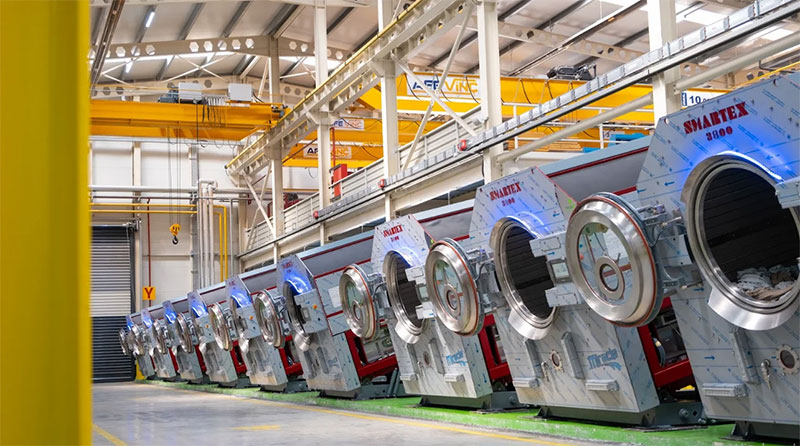Cavitation finds an excellent field of application in the laundries: one of the activities that consumes the most water in absolute proportion to guarantee, especially in periods of health emergency, a correct level of cleaning and sterilization.
The water used by laundries is actually not extremely polluted and the purification plants which they are obliged to equip themselves with in order to be able to discharge it into the sewer system within the table limits can be replaced with devices which allow total reuse of the water, except for fraction lost by evaporation.
By subjecting unpurified water deriving from a normal process of use within an industrial laundry to cavitation, the treatment unleashes a powerful floating effect capable of increasing the total suspended solids by 953%; this is due to the micro-jets and hydroxyl radicals which aggregate some materials present such as, for example, the fibres.

The solids, subject to flotation, separate from the liquids and, at that point, can be easily filtered, leaving the water ready for a subsequent processing cycle aimed at completing the purification treatment.
|
|
AS IS |
|
54” cavitation |
difference |
|
pH |
10 |
> > > > > > > > > > > > > > > > |
10 |
0% |
|
Electrical conductivity mS/cm at 20°C |
2,16 |
2,15 |
0% |
|
|
Total suspended solids mg/L |
95 |
1000 |
953% |
|
|
COD (Chemical Oxygen Demand) mg/L O2 |
510 |
490 |
-4% |
|
|
BOD5 mg/L O2 |
210 |
200 |
-5% |
|
|
Total hardness °f |
<10 |
<10 |
= |
|
|
Salinity as NaCl (by calculation) mg/L NaCl |
412 |
429 |
4% |
|
|
Phosphates mg/L PO4 |
<0,5 |
<0,5 |
= |
|
|
Chlorides mg/L Cl- |
250 |
260 |
4% |
|
|
Nitric nitrogen mg/L N-NO3 |
1,6 |
1,7 |
6% |
|
|
Cationic surfactants mg/L |
1 |
1,4 |
40% |
|
|
Nonionic surfactants mg/L |
41 |
41 |
= |
COD and BOD decrease after treatment due to oxidation, but the decrease occurs in a non-significant way as the literal explosion of suspended solids does not allow these values to drop adequately.
The physical effect has reduced the alkyl chains present, destroying more complex organic molecules, reducing them into simpler molecules and, therefore, treatable more easily and in a shorter amount of time.
The EMPOWERING DEVICE manages to unleash the maximum desired effect in 54 seconds: subjecting the waters of the washing process to a cavitation treatment of longer duration, without any corrective action, is not economically viable.
The quantity of ozone administered is sufficient but doubling it allows a faster oxidation of the nitric nitrogen present.
Once the suspended solids, partly also responsible for the levels of COD and BOD, have been eliminated through filtration with a sand filter, it appears appropriate to subject the wastewater to a second rapid but intense cavitation cycle in order to break down the last pollutants and obtain thus a fully reusable water in the production cycle.
The water, deprived of the solids, is added with a few mg/l of ferrous sulphate at the filter outlet and via a dosing pump to then complete the purification process with a second cavitation treatment, lasting 36 or 54 seconds (respectively a “short” or “medium” processing cycle in the non-demonstrative machinery), which, also making use of the action of the ozone and the UV lamps present in the apparatus, would enhance the Fenton reaction: the ferrous ion (2) is oxidized by the peroxide of hydrogen to ferric ion (3) with the formation of a hydroxyl radical and a hydroxide ion. Iron (3) is then reduced by another hydrogen peroxide molecule to iron (2) with the formation of a peroxy radical and a proton:
(1) Fe2+ + H2O2 —> Fe3+ + OH· + OH−
(2) Fe3+ + H2O2 —> Fe2+ + OOH· + H+
As can be seen from the two previous formulas, the net products are water and the two hydroxyl and peroxidic radicals, which are the same ones that are formed during cavitation. In these conditions all the organic material is oxidized and the water, after a second filtration, can be reintroduced into the production cycle, except for that which should evaporate naturally.
For a process of this kind, the adoption of the EMPOWERING DEVICE TWIN-SET: model is recommended: in this way it is possible to process the wastewater on a continuous process line, cutting the cost of accessories and avoiding bottlenecks in the processing. Given the processing peaks, storage tanks for the treated water are also recommended, capable of storing an adequate quantity necessary to make up for the peak usage of the day.















